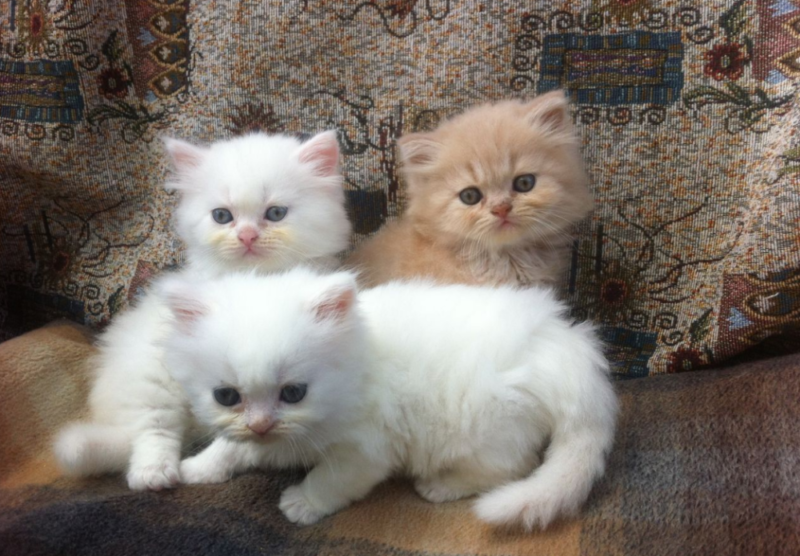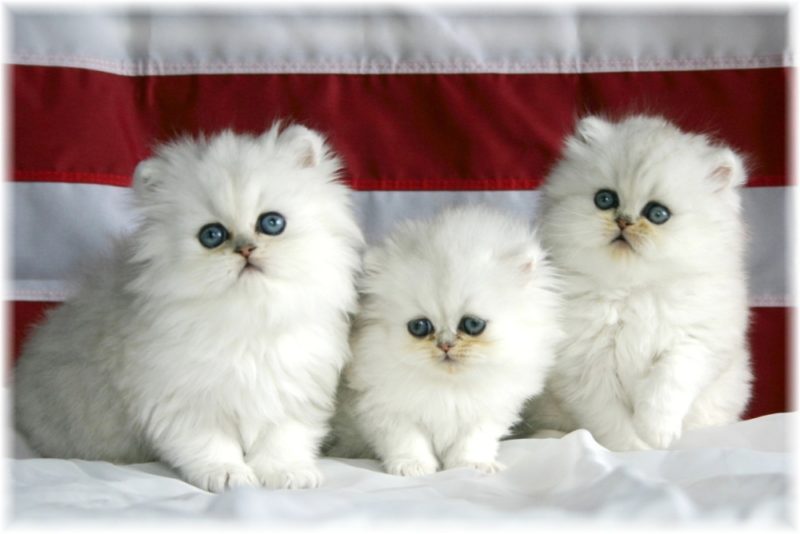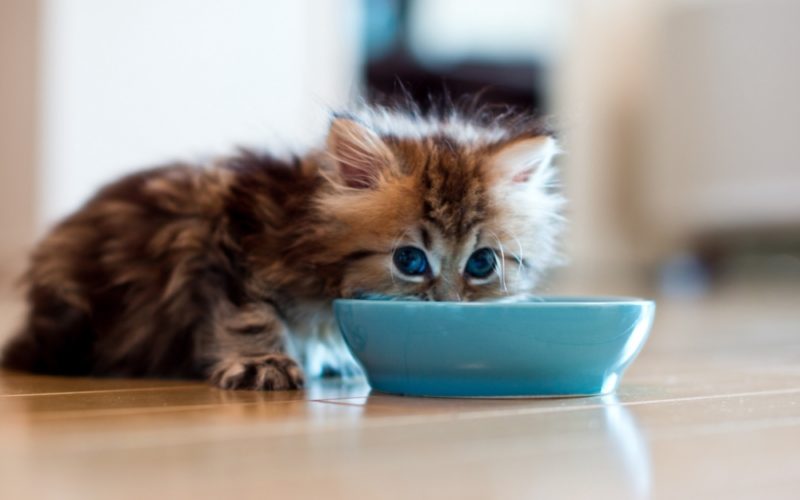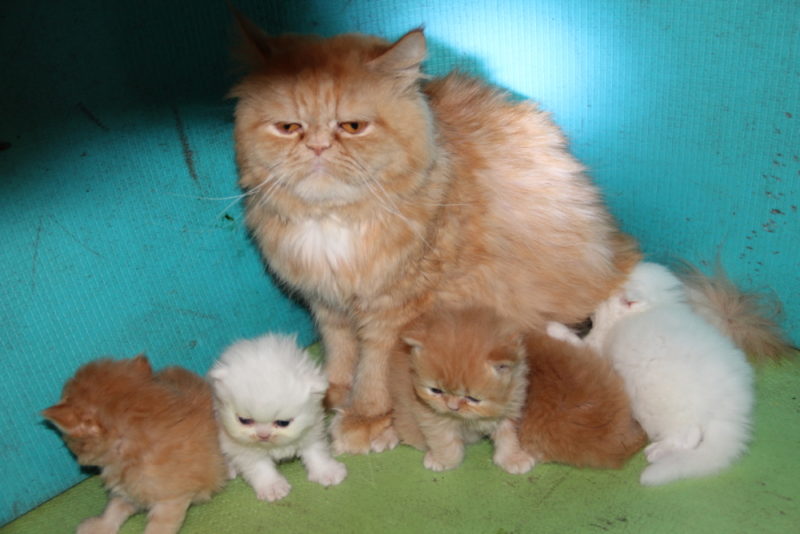Persian kittens are one of the most unique and oldest breeds of cats. Graceful animals possess gorgeous thick hair and a special “childish” expression of their faces, for which they have been popular among breeders for centuries. And their flexible and peaceful disposition only contributes to these qualities.
Material Content:
Description and characteristics of the breed
A distinctive characteristic of the breed is a lush “lion” mane, short and strong limbs, as well as a small upturned wide nose.
It is depending on its location and shape that several main pedigree species of Persians are distinguished:
- Classical (British). Their nose is straight and located just below the eyes. (Animals with such parameters are not allowed for breeding, since the species is considered obsolete).
- Extreme (exotic). The nose is located at the level of the inner corners of the eyes, which makes it seem upturned, like a Pekingese.
- Modern European (short-nosed). The nose is on a par with the lower eyelids. There is no “gloomy” expression of the muzzle, as individuals have large open eyes.
Due to breed features in the natural habitat, the Persians do not survive. These are real couch potatoes who are absolutely not interested in what is happening outside the walls of their place of residence. Animals are ideal as a family "doctor" or the keeper of the hearth.
By nature, Persian cats are flexible, very trusting and immensely loyal to their owner.They will be happy to spend the whole evening on their lap.
Persians are very fond of affection, attention and care, but they themselves will not be imposed.
They stoically endure even the annoyance and games of young children. But the strangers are wary.
The temperament of the representatives of this breed is phlegmatic and not at all aggressive. Animals are very smart, because they quickly become accustomed to the tray and respond well to education.
A distinctive feature of cats is silence. Due to the aristocratic nature, the Persian rarely meows, but with pleasure purrs, being next to the owner.
The history of the origin of Persian kittens
In the process of development, the breed underwent many changes, therefore it is not known for certain about its origin. However, studies of domestic and foreign felinologists confirm that the Persians descended from Asian and desert cats, as well as a wild cat-manul. The birthplace of the breed is Persia (modern Iran), where from the beginning of the XVII century Pietro della Valle, a famous traveler, brought several individuals to Italy. A little later, through the efforts of a French diplomat, they came to Cardinal Richelieu. Animals were extremely popular at the court of the English Queen Victoria.
In Russia, Persian kittens appeared only in the 80s and immediately began to be considered an item of unprecedented luxury.
Standard and Pet Choice
According to the standard established by the World Cat Federation, modern Persians are distinguished by the following pedigree characteristics:
- trunk - medium in size, stocky, with a massive, muscular sternum;
- the head is round, large, with a wide skull, a forehead protruding forward, chubby cheeks and strong jaws;
- the nose is upturned and short (the length of the back does not exceed its width);
- ears are small, rounded, widely spaced;
- paws - strong, short, rounded;
- eyes - large, set wide, shiny;
- the tail is fluffy, not very long;
- neck - short, thick;
- coat - silky, with copious undercoat, can reach a length of up to 20 cm;
- weight - about 5 - 8 kg (in an adult animal).
During the selection process, more than 100 shades of kitten coat hair were bred, so felinologists prefer to classify individuals by eye color:
- Yellow. These include tabby (ticked) and smoky colors, as well as plain (solid) red, white, black and tortoiseshell shades.
- Greens. This type is distinguished by complex colors: chinchilla or silver shaded.
- Blue. This eye color is combined with bright marks on a light background (color point). The colors are quite diverse.
The rarest shade of Persian wool is orange (red).
Breed signs in kittens appear at the age of 13 weeks, because breeders recommend choosing a pet after reaching the specified period after birth. And it is also worth paying attention to the conditions of the animal, get acquainted with its pedigree and learn about the state of health. A thoroughbred kitten is distinguished by mobility, a symmetrical muzzle, a regular jaw, smooth beautiful hair without bald patches. The ears and eyes of the pet are clean, without discharge, and there are no creases on the tail.
It is best to purchase a future pet in a specialized nursery.
Features of caring for a long-haired animal
Persians, like other long-haired cats, need careful care for their luxurious fur coat. To maintain a neat appearance and health of the animal, it is necessary to comb it daily for half an hour. The procedure will avoid the formation of tangles and entanglements that are difficult to remove later. In addition, bald spots or bald patches are a serious disadvantage when participating in exhibitions.
Breeders recommend Persian bathing 1-2 times a month (depending on the season). After the procedure, the wool must be thoroughly dampened with a towel and combed until it completely dries.
An important aspect of caring for a long haired cat is a haircut. Only color points can be an exception to the rule, since such manipulation can lead to a change in their shade of coat.
Persian kittens feeding
The nutrition of the Persians, regardless of type, must be of high quality and balanced.
Veterinarians recommend feeding cats, focusing on their age and state of health.
By this principle, you can choose ready-made compounds for:
- young individuals;
- adult pets;
- Aging or having special needs animals (sick, neutered and others).
With a natural type of nutrition, you should adhere to the following formula:
- dietary meat (40%);
- milk components and egg white (20%);
- offal (15%);
- plant fiber (20%).
It is strictly forbidden to use Persian cats in the diet:
- bones;
- high-fat dairy products;
- potatoes;
- mushrooms;
- eggplant;
- bakery products;
- spices and spices;
- fatty meats.
The animal in the public domain should always have clean water.
Ear and eye care
The specific location of the eyes and the structure of the facial bones in the Persians provokes constant discharge from the lacrimal ducts. To avoid inflammation, it is necessary to wipe your eyes daily with a napkin with a special solution. If the discharge becomes cloudy, you should immediately consult a veterinarian. Normally, tears should be transparent.
Newborn kittens are born blind. The eyelids begin to open only on the 5-10th day. If this does not happen, it is advisable to rinse the eyes with warm water for several days using a cotton pad.
The ears also need to be carefully looked after. Once a week they are treated with a cotton swab dipped in a special cosmetic product. Breeders do not recommend using hydrogen peroxide.
Persian diseases
Timely vaccinations for Persian kittens and quality care are the key to excellent animal health.
However, such pets are predisposed to certain diseases:
- polycystic kidney disease (appears at the age of 3-10 years);
- retinal atrophy (often leads to blindness);
- watery eyes;
- hypertrophic cardiomyopathy;
- colds;
- urolithiasis;
- diarrhea.
Due to the structural features of the nasal septum, cats snore and sniff during sleep. And also representatives of the breed often suffer from plaque.
To prevent possible problems, it is necessary to be examined by a veterinarian every 2-3 months.
With proper care, cats live an average of 15–20 years.
Advantages and disadvantages of the breed
The breeders include the positive characteristics of Persian beauties:
- good nature;
- beauty
- learning ability;
- devotion;
- quiet voice".
The disadvantages of the breed are:
- difficulty in leaving;
- molting;
- need for attention.
Despite the complexity of looking after such individuals, as well as their poor health, Persians are one of the most popular cat breeds. Their beauty, devotion and intellect are on the battlefield, and the efforts spent on care are returned a hundredfold over the long life of a beloved pet.



















